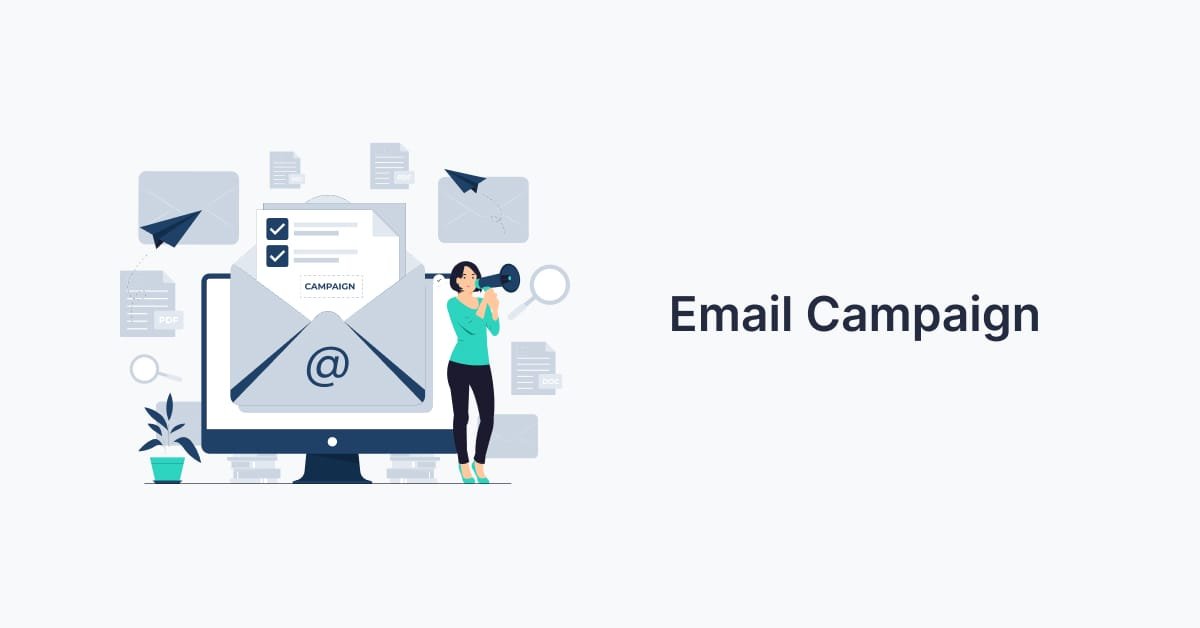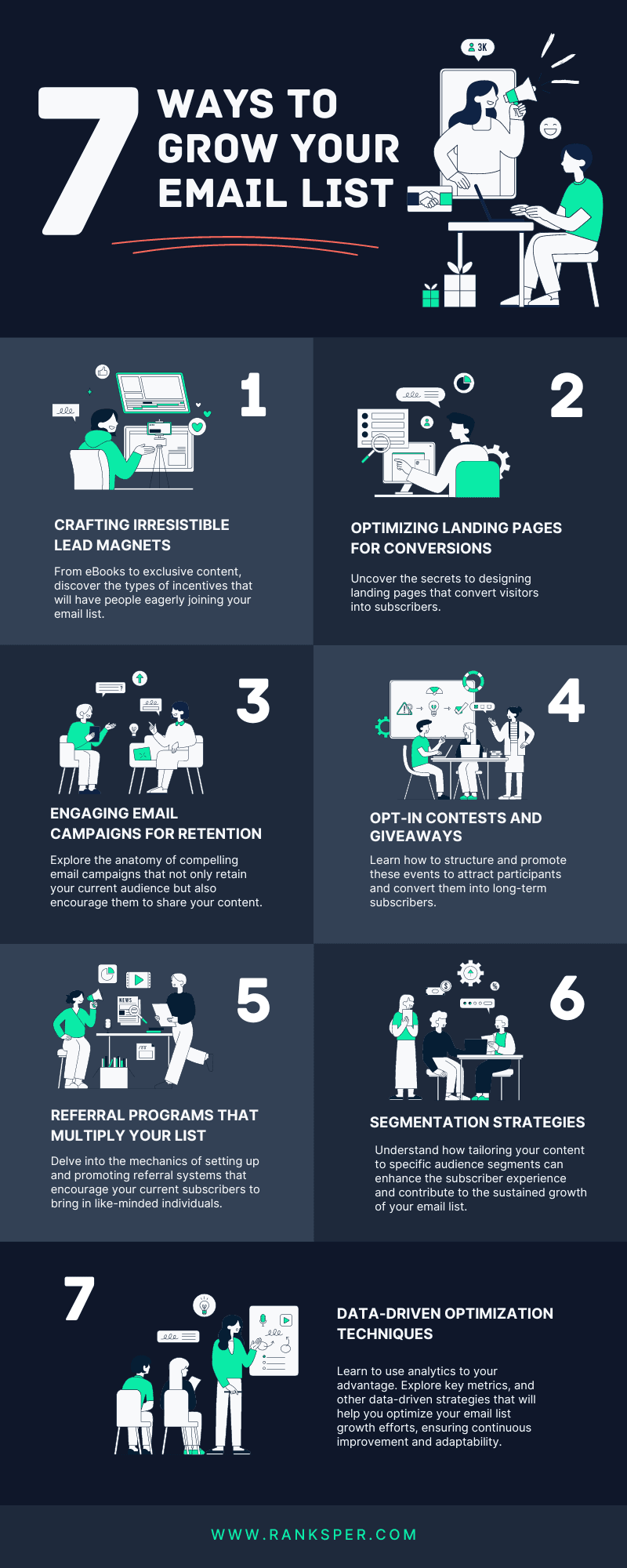In the ever-evolving landscape of digital marketing, one tool remains consistently effective: email marketing.
Despite the rise of social media and other digital outreach platforms, email marketing holds its ground. It’s a powerful tool for audience engagement and a cornerstone of successful digital marketing strategies.
But why is email marketing so effective?
The answer lies in its direct and personal nature. Emails land directly in a user’s inbox, making it a highly personal form of communication. This direct line of communication allows businesses to build strong relationships with their customers.
However, the effectiveness of email marketing doesn’t come without effort. It requires a well-thought-out strategy, careful execution, and constant optimization. This is where many small business owners, digital marketing novices, and content writers face challenges.
Understanding and implementing effective email marketing strategies can be complex. It involves a deep understanding of your audience, crafting compelling content, and analyzing data for continuous improvement.
This is where our guide comes in.
In this comprehensive guide, we will explore 18 email marketing strategies for a successful campaign in 2024. We aim to provide you with practical, step-by-step guidance to improve your email marketing efforts.
Whether you’re a small business owner looking to increase your online visibility, a digital marketing novice trying to grasp the complexities of SEO, or a content writer aiming to incorporate SEO strategies into your writing, this guide is for you.
We will delve into the importance of email marketing, the latest trends, and how to craft and implement effective strategies. We will also discuss how to measure the success of your campaigns and how to optimize them for better results.
So, are you ready to take your email marketing to the next level? Let’s dive in and explore the world of email marketing strategies for a successful campaign in 2024.
Understanding the Role of Email Marketing in Digital Outreach
Email marketing is more than just sending out newsletters or promotional offers. It’s a strategic tool for digital outreach, playing a crucial role in engaging your audience, building relationships, and driving conversions.
But what exactly is digital outreach?
Digital outreach is the process of reaching out to your audience through digital channels. It involves creating and sharing valuable content to engage your audience, build trust, and ultimately drive them to take action.
Email marketing fits perfectly into this framework. Here’s why:
- Direct Communication: Email marketing allows you to communicate directly with your audience. Unlike social media where your message can get lost in the noise, emails land directly in a user’s inbox, making it more personal and direct.
- Audience Engagement: With email marketing, you can engage your audience with valuable content, personalized offers, and interactive elements. This helps to build a strong relationship with your audience.
- Conversion Driver: Emails can drive conversions. Whether it’s making a purchase, signing up for a webinar, or downloading a resource, a well-crafted email can motivate your audience to take action.
- Customer Retention: Email marketing is not just about acquiring new customers. It’s also about retaining existing ones. Regular communication through emails can keep your brand top-of-mind and encourage repeat business.
- Measurable Results: One of the biggest advantages of email marketing is its measurability. With the right tools, you can track open rates, click-through rates, conversions, and more. This data can provide valuable insights to optimize your campaigns.
Understanding the role of email marketing in digital outreach is the first step towards crafting effective email marketing strategies. In the following sections, we will delve deeper into how to leverage email marketing for successful digital outreach.
The Evolution of Email Marketing: What’s New in 2024?
Email marketing has come a long way since its inception. From simple text-based emails to rich, interactive content, the evolution of email marketing has been driven by technological advancements and changing consumer behaviors.
So, what’s new in 2024? Here are some key trends shaping the future of email marketing:
- Personalization 2.0: Personalization in email marketing is not new. But in 2024, it’s all about hyper-personalization. This means using data to create highly personalized content that resonates with each individual subscriber.
- AI and Machine Learning: Artificial Intelligence (AI) and Machine Learning are playing a significant role in email marketing. From predictive analytics to automated content creation, these technologies are helping marketers to optimize their email campaigns.
- Interactive Emails: Interactive elements like polls, surveys, and carousels are making emails more engaging. These elements not only enhance the user experience but also increase the chances of conversions.
- Voice Assistants: With the rise of voice assistants like Alexa and Google Assistant, voice-activated emails are becoming a reality. This means optimizing your emails for voice search and considering how your emails sound when read aloud.
- Privacy Regulations: With new privacy regulations like GDPR and CCPA, marketers need to be more careful about how they collect and use email data. This means more transparency and giving users more control over their data.
These trends are shaping the future of email marketing. By understanding and adapting to these trends, you can stay ahead of the curve and make the most of your email marketing efforts.
In the next sections, we will explore how to leverage these trends to craft effective email marketing strategies.
Crafting Your Email Marketing Goals: Aligning with Business Objectives
Before you dive into the specifics of your email marketing strategies, it’s crucial to define your goals. These goals should align with your overall business objectives and provide a clear direction for your email marketing efforts.
For instance, if your business objective is to increase sales, your email marketing goal could be to drive more traffic to your product pages. If your objective is to improve customer retention, your goal could be to increase engagement with your email content.
Remember, your goals should be SMART – Specific, Measurable, Achievable, Relevant, and Time-bound. This means instead of setting a vague goal like “increase email open rates”, you should aim for something more specific like “increase email open rates by 10% in the next quarter”.
Once you have defined your goals, you can start crafting your email marketing strategies. These strategies should be designed to help you achieve your goals. For example, if your goal is to increase email open rates, your strategies could include crafting compelling subject lines or segmenting your email list for more targeted messaging.
In the end, your email marketing goals are the foundation of your email marketing strategies. By aligning these goals with your business objectives, you can ensure that your email marketing efforts contribute to the overall success of your business.
Building and Segmenting Your Email List for Targeted Campaigns

Building a robust email list is the first step towards a successful email marketing campaign. However, it’s not just about the number of subscribers. The quality of your email list is equally important.
To build a high-quality email list, focus on attracting subscribers who are genuinely interested in your products or services.
You can do this by offering valuable content in exchange for their email address, such as a free ebook, a discount code, or access to exclusive content.
Once you have built your email list, the next step is to segment it. Email list segmentation involves dividing your email list into smaller groups based on specific criteria. These criteria could be demographic information, purchase history, or engagement with previous emails.
Here are some ways you can segment your email list:
- Demographics: Age, location, gender, occupation, etc.
- Behavior: Purchase history, website activity, email engagement, etc.
- Psychographics: Interests, values, attitudes, etc.
- Lifecycle stage: New subscribers, active customers, inactive customers, etc.
Segmenting your email list allows you to send targeted emails to each group. This not only increases the relevance of your emails but also improves your open and click-through rates.
For example, if you run an online clothing store, you can segment your email list based on gender. This way, you can send targeted product recommendations to each group, increasing the chances of them making a purchase.
Building and segmenting your email list is a crucial part of your email marketing strategy. It allows you to send targeted and relevant emails, improving your engagement rates and ultimately, your sales.
Personalization: The Key to Audience Engagement
In today’s digital age, consumers expect personalized experiences. They want to feel understood and valued by the brands they interact with. This is where personalization comes into play in email marketing.
Personalization involves tailoring your emails to meet the specific needs and preferences of each subscriber. It goes beyond simply addressing the subscriber by their first name. It’s about delivering relevant content that resonates with them on a personal level.
Here are some ways you can personalize your emails:
- Product recommendations: Based on the subscriber’s browsing and purchase history.
- Birthday emails: Send a special offer or message on the subscriber’s birthday.
- Abandoned cart emails: Remind subscribers of the products they left in their cart.
- Re-engagement emails: Target inactive subscribers with special offers or content.
Personalized emails can significantly improve your email marketing performance. According to a study by Campaign Monitor, emails with personalized subject lines are 26% more likely to be opened. Furthermore, personalized emails deliver six times higher transaction rates.
However, to effectively personalize your emails, you need to collect and analyze data about your subscribers. This includes their demographic information, browsing behavior, purchase history, and email engagement.
Remember, personalization is not about invading your subscribers’ privacy. It’s about using the data you have to provide a more relevant and valuable experience. Always respect your subscribers’ privacy and comply with data protection regulations.
Personalization is a powerful tool in email marketing. It allows you to connect with your subscribers on a deeper level, improving your engagement rates and ultimately, your sales.
Designing Mobile-Friendly Emails for Optimal Reach
In the era of smartphones, designing mobile-friendly emails is no longer an option—it’s a necessity. According to Statista, over half of all web traffic comes from mobile devices. This means that a significant portion of your subscribers are likely reading your emails on their phones.
If your emails aren’t optimized for mobile, you risk losing out on a large chunk of your audience. Subscribers may delete your emails or even unsubscribe if they can’t easily read and interact with your content on their mobile devices.
Here are some tips for designing mobile-friendly emails:
- Use a responsive design: This ensures that your emails automatically adjust to fit the screen size of the device they’re viewed on.
- Keep your layout simple: Avoid complex designs that may not display correctly on smaller screens.
- Use a large, legible font: Small text can be difficult to read on mobile devices.
- Include clear, easy-to-tap calls to action: Make sure your buttons are large enough to be easily tapped with a finger.
- Limit the use of images: Too many images can slow down the loading time of your emails on mobile devices.
Remember, the goal of your emails is not just to be read, but to drive action. If subscribers can’t easily navigate your emails on their mobile devices, they’re less likely to take the desired action, whether that’s making a purchase, signing up for a webinar, or reading your latest blog post.
Writing Compelling Subject Lines to Boost Open Rates
The subject line is the first thing your subscribers see when they receive your email. It’s your chance to make a strong first impression and entice them to open your email. A compelling subject line can significantly boost your open rates, leading to higher engagement and conversions.
Here are some tips for writing compelling subject lines:
- Keep it short and sweet: Most email clients cut off subject lines after about 60 characters. Keep your subject lines concise to ensure they’re fully visible in your subscribers’ inboxes.
- Use action-oriented language: Encourage your subscribers to take action by using verbs in your subject lines.
- Create a sense of urgency: Subject lines that convey a sense of urgency can prompt subscribers to open your emails immediately.
- Personalize it: Personalized subject lines can increase open rates by up to 50%. Include your subscriber’s name or other personal information in the subject line to grab their attention.
- Test, test, test: Use A/B testing to find out what types of subject lines resonate most with your audience.
Remember, your subject line should accurately reflect the content of your email. Misleading subject lines may increase your open rates in the short term, but they can damage your reputation and lead to higher unsubscribe rates in the long run.
In conclusion, a compelling subject line is key to getting your emails opened and read. By following these tips, you can write subject lines that grab your subscribers’ attention and boost your email open rates.
The Power of A/B Testing in Refining Your Email Strategy
A/B testing, also known as split testing, is a powerful tool for refining your email strategy. It involves sending two versions of an email to different segments of your audience and comparing their performance to determine which one is more effective.
Here are some elements you can test in your emails:
- Subject lines: As discussed in the previous section, your subject line can significantly impact your open rates. Test different subject lines to see which ones resonate most with your audience.
- Email content: Try different types of content, such as text, images, and videos, to see what your audience prefers.
- Call-to-action (CTA): Experiment with different CTA text, colors, and placement to find out what drives the most clicks.
- Send times: Test different send times to find out when your audience is most likely to open and engage with your emails.
- Personalization: Try different levels of personalization to see what your audience responds to best.
When conducting A/B tests, it’s important to only test one element at a time. This way, you can accurately determine which change led to any differences in performance.
A/B testing is a powerful tool for refining your email strategy. By testing different elements of your emails, you can gain valuable insights into your audience’s preferences and behaviors, allowing you to optimize your emails for better performance.
Email Automation: Streamlining Your Digital Marketing Efforts
Email automation is a game-changer in the realm of digital marketing. It allows you to send out emails to your subscribers automatically, based on triggers you set. This not only saves you time but also ensures that your emails are timely and relevant to your audience.
Here are some ways you can use email automation to streamline your digital marketing efforts:
- Welcome emails: When someone subscribes to your email list, you can automatically send them a welcome email. This is a great way to start building a relationship with your new subscriber.
- Follow-up emails: If a subscriber takes a certain action, such as making a purchase or downloading a resource, you can automatically send them a follow-up email. This can help to increase engagement and drive further actions.
- Reminder emails: If you’re running an event or promotion, you can set up automated emails to remind your subscribers about it. This can help to boost attendance or participation.
- Re-engagement emails: If a subscriber hasn’t engaged with your emails for a while, you can automatically send them a re-engagement email. This can help to rekindle their interest in your brand.
Email automation can also help you to segment your audience and send more targeted emails. For example, you can set up different email sequences for new subscribers, active customers, and dormant subscribers. This can help to increase the relevance of your emails and improve your engagement rates.
So, email automation is a powerful tool for streamlining your digital marketing efforts. By automating your emails, you can ensure that they are timely, relevant, and personalized to your audience, helping to boost your engagement rates and drive more conversions.
Integrating Email Marketing with Other Digital Channels
In the digital age, marketing is no longer about using a single channel. It’s about creating a seamless experience across multiple channels. Email marketing is a powerful tool, but it becomes even more effective when integrated with other digital channels.
Here are some ways you can integrate email marketing with other digital channels:
- Social Media: You can use email marketing to promote your social media profiles and vice versa. For example, you can include social media buttons in your emails, or use social media to encourage people to sign up for your email list.
- Website: Your website and email marketing should work hand in hand. You can use your website to collect email addresses, and use email marketing to drive traffic back to your website.
- Content Marketing: If you’re creating valuable content, use email marketing to distribute it. This can help to increase your content’s reach and engagement.
- SEO: While email marketing doesn’t directly affect SEO, it can help to drive traffic to your website, which can boost your SEO efforts.
By integrating email marketing with other digital channels, you can create a more cohesive and effective marketing strategy. This can help to increase your reach, engagement, and conversions.
That’s why integrating email marketing with other digital channels is a key strategy for maximizing your digital marketing efforts. By creating a seamless experience across multiple channels, you can engage your audience more effectively and drive better results.
Navigating Compliance: GDPR and Email Marketing Regulations
In the world of email marketing, compliance is key. It’s not just about sending emails that your audience will love, but also about respecting their privacy and adhering to regulations.
One of the most important regulations to consider is the General Data Protection Regulation (GDPR). This European Union law has had a significant impact on email marketing, requiring businesses to be more transparent about how they collect, use, and store personal data.
Here are some key points to consider when it comes to GDPR and email marketing:
- Consent: Under GDPR, you must obtain explicit consent from individuals before you can send them marketing emails. This means you can’t automatically add people to your email list without their permission.
- Transparency: You must be clear about how you’re going to use people’s data. This includes providing information about how long you’ll keep their data and who it will be shared with.
- Right to Access and Erasure: Individuals have the right to access their personal data and request that it be erased. You must have processes in place to handle these requests.
In addition to GDPR, there are other regulations like the CAN-SPAM Act in the U.S. and CASL in Canada that you need to be aware of. These laws have their own requirements for things like consent and unsubscribe options.
Navigating compliance in email marketing can be complex, but it’s essential for maintaining trust with your audience and avoiding hefty fines. Always stay updated with the latest regulations and ensure your email marketing practices are compliant.
Leveraging AI and Machine Learning for Enhanced Email Campaigns
Artificial Intelligence (AI) and Machine Learning (ML) are revolutionizing the way we approach email marketing. These technologies can analyze vast amounts of data, identify patterns, and make predictions, all of which can be used to enhance your email campaigns.
One of the key benefits of AI and ML in email marketing is personalization. These technologies can analyze user behavior and preferences to create highly personalized email content. This can significantly improve engagement rates and conversions.
Here are some ways you can leverage AI and ML in your email marketing:
- Predictive Analytics: AI can analyze past behavior to predict future actions. This can help you identify which customers are most likely to make a purchase or unsubscribe from your list.
- Content Optimization: AI can help you determine the best content for each individual. This includes everything from the subject line to the body of the email.
- Send Time Optimization: AI can analyze when each subscriber is most likely to open an email and schedule the email to be sent at that time.
- Automated Responses: AI can automate responses to common customer inquiries, freeing up time for your team to focus on more complex tasks.
However, it’s important to remember that AI and ML are tools to assist you, not replace you. The human touch is still crucial in creating genuine connections with your audience.
Crafting a Clear and Compelling Call-to-Action (CTA)
A Call-to-Action (CTA) is a crucial element in your email marketing strategy. It’s the part of your email that prompts your audience to take a specific action, such as making a purchase, signing up for a webinar, or downloading a resource.
A well-crafted CTA can significantly increase your click-through rates and conversions. Here are some tips for creating a clear and compelling CTA:
- Be Specific: Your CTA should clearly state what you want your audience to do. Avoid vague phrases like “click here” and instead use specific phrases like “download our free guide” or “sign up for our webinar”.
- Create Urgency: Creating a sense of urgency can encourage your audience to take action immediately. You can do this by using phrases like “limited time offer” or “only a few spots left”.
- Make it Stand Out: Your CTA should be visually distinct from the rest of your email. Use contrasting colors, bold text, or a button to make your CTA stand out.
- Keep it Short: A good CTA is concise and to the point. Aim for no more than five words.
Remember, the goal of your CTA is to guide your audience towards a desired action. By crafting a clear and compelling CTA, you can significantly improve the effectiveness of your email marketing campaigns.
Measuring Success: Email Marketing Analytics and KPIs
Understanding the performance of your email marketing campaigns is crucial to their success. This is where email marketing analytics and Key Performance Indicators (KPIs) come into play.
These metrics provide insights into how your emails are performing and help you identify areas for improvement. Here are some key email marketing KPIs you should be tracking:
- Open Rate: This is the percentage of recipients who open your email. A low open rate could indicate that your subject lines aren’t compelling enough or that your emails are being marked as spam.
- Click-Through Rate (CTR): This is the percentage of recipients who click on a link within your email. A low CTR could suggest that your email content isn’t engaging or that your CTA isn’t clear.
- Conversion Rate: This is the percentage of recipients who complete a desired action after clicking on a link in your email, such as making a purchase or signing up for a webinar.
- Bounce Rate: This is the percentage of emails that couldn’t be delivered to the recipient’s inbox. A high bounce rate could indicate that you have many invalid email addresses on your list.
- Unsubscribe Rate: This is the percentage of recipients who opt out of your email list after receiving an email. A high unsubscribe rate could suggest that your content isn’t meeting your audience’s expectations.
By regularly monitoring these KPIs, you can gain a better understanding of what’s working and what’s not in your email marketing campaigns. This data can then inform your future strategies, helping you to continually improve your email marketing performance and achieve your business goals.
Maintaining Email List Hygiene for Higher Engagement Rates
Maintaining a clean and healthy email list is a critical aspect of successful email marketing. This process, known as email list hygiene, involves regularly cleaning your email list by removing inactive, invalid, or unengaged subscribers.
A well-maintained email list can lead to higher engagement rates, improved deliverability, and better overall email marketing performance. Here are some steps you can take to maintain your email list hygiene:
- Remove Inactive Subscribers: If a subscriber hasn’t opened or clicked on your emails in a certain period, consider removing them from your list. They’re likely not interested in your content and are just taking up space.
- Check for Invalid Email Addresses: Regularly check your list for invalid email addresses. These could be emails that have been entered incorrectly or are no longer in use. Removing these can improve your deliverability rate.
- Offer an Easy Unsubscribe Option: Make it easy for subscribers to opt out of your emails if they wish. This can help you maintain a list of engaged and interested subscribers.
- Segment Your List: Segmenting your list can help you send more targeted and relevant content, which can improve engagement rates.
By maintaining your email list hygiene, you can ensure that your emails are reaching the right people, leading to more effective email marketing campaigns. Remember, the quality of your email list is much more important than the quantity.
Creative Content Strategies for Email Marketing
Creating engaging and relevant content is key to successful email marketing. It’s not just about selling your products or services, but also about providing value to your subscribers. Here are some creative content strategies you can use in your email marketing:
- Educational Content: Share useful tips, how-to guides, or industry news with your subscribers. This type of content can help establish your brand as a thought leader in your industry.
- Personal Stories: Sharing personal stories or experiences can help humanize your brand and build a stronger connection with your audience.
- User-Generated Content: Showcase reviews, testimonials, or photos from your customers. This not only provides social proof but also encourages more user-generated content.
- Exclusive Offers or Discounts: Reward your subscribers with exclusive offers or discounts. This can help increase sales and also make your subscribers feel valued.
- Interactive Content: Include quizzes, surveys, or interactive infographics in your emails to increase engagement.
Remember, the goal of your email content should be to provide value to your subscribers. This can help build trust and loyalty, leading to higher engagement and conversion rates.
A successful email marketing strategy involves more than just sending out promotional emails. It requires creating engaging and valuable content that resonates with your subscribers. By implementing these creative content strategies, you can enhance your email marketing efforts and achieve better results.
Timing and Frequency: When to Send Your Emails
Determining the optimal timing and frequency for your emails can significantly impact your email marketing success. It’s crucial to strike a balance that keeps your brand at the forefront of your subscribers’ minds without overwhelming them.
The best time to send emails can vary depending on your audience. Some studies suggest that weekdays, particularly Tuesday and Thursday, see higher open rates. However, it’s essential to understand your audience’s habits and preferences.
For instance, if your target audience is working professionals, they might be more likely to check their emails during the workweek. On the other hand, if your audience is primarily students, they might be more likely to check their emails on weekends or in the evenings.
As for frequency, it’s generally recommended to send at least one email per week to stay relevant. However, the optimal frequency can depend on various factors, including your industry, the type of content you’re sending, and your audience’s preferences.
Here are some tips to help you determine the best timing and frequency for your emails:
- Test Different Times and Days: Experiment with sending your emails on different days and at different times to see when you get the highest open rates.
- Consider Your Audience’s Schedule: Think about when your audience is most likely to check their emails and schedule your emails accordingly.
- Monitor Your Metrics: Keep an eye on your email metrics to see how changes in timing and frequency affect your open rates and click-through rates.
- Ask Your Subscribers: Consider sending a survey to your subscribers to ask them when they prefer to receive emails.
In conclusion, the timing and frequency of your emails can significantly impact your email marketing success. By understanding your audience’s habits and preferences, testing different times and days, and monitoring your metrics, you can optimize your email schedule for the best results.
Overcoming Email Deliverability Challenges
Email deliverability is a critical aspect of any email marketing strategy. It refers to the ability of your emails to reach the inbox of your subscribers without being flagged as spam or bouncing back.
Several factors can affect your email deliverability, including the quality of your email list, the content of your emails, and your sender reputation. If your emails are not reaching your subscribers’ inboxes, it can significantly impact your email marketing success.
Here are some strategies to overcome email deliverability challenges:
- Maintain a Clean Email List: Regularly clean your email list to remove inactive subscribers and incorrect email addresses. This can help improve your sender reputation and increase your deliverability rate.
- Avoid Spam Triggers: Certain words and phrases can trigger spam filters. Avoid using these in your subject lines and email content.
- Authenticate Your Emails: Use email authentication methods like SPF, DKIM, and DMARC to verify your emails and improve your deliverability.
- Monitor Your Metrics: Keep an eye on your email metrics, such as bounce rates and spam complaints, to identify and address any deliverability issues.
To enhance the deliverability of your emails and make sure they reach your subscribers’ inboxes, it is crucial to keep your email list clean, steer clear of spam triggers, authenticate your emails, and regularly monitor your metrics.
Growing Your Email Subscriber List with Effective Lead Magnets

Growing your email subscriber list is a crucial part of your email marketing strategy. The more subscribers you have, the wider your reach and the greater your chances of driving conversions and sales. One effective way to grow your email list is by using lead magnets.
Lead magnets are incentives that you offer to potential subscribers in exchange for their email address. They can be anything from a free ebook or a discount code to a webinar or a free trial of your product or service.
Here are some strategies for using lead magnets to grow your email subscriber list:
- Offer Value: Your lead magnet should offer real value to your potential subscribers. It should be something that they find useful and relevant to their needs or interests.
- Make It Exclusive: Make your lead magnet exclusive to your email subscribers. This can create a sense of urgency and encourage more people to subscribe.
- Promote Your Lead Magnet: Promote your lead magnet on your website, social media channels, and other marketing platforms to reach a wider audience.
- Make It Easy to Access: Make your lead magnet easy to access. The process of subscribing and accessing the lead magnet should be simple and straightforward.
In conclusion, using lead magnets is an effective way to grow your email subscriber list. By offering value, making your lead magnet exclusive, promoting it widely, and making it easy to access, you can attract more subscribers and grow your email list. This, in turn, can help enhance your email marketing efforts and drive your business success.
Using lead magnets is a highly effective method for expanding your email subscriber list. By providing valuable content, keeping the lead magnet exclusive, actively promoting it, and ensuring easy accessibility, you can attract more subscribers and achieve substantial growth in your email list. Consequently, this will significantly improve your email marketing efforts and contribute to the overall success of your business.
Email Retargeting: Re-engaging Customers and Boosting Sales
Email retargeting is a powerful strategy that can help you re-engage customers who have shown interest in your products or services. It involves sending targeted emails to customers based on their previous interactions with your business.
For instance, if a customer added a product to their cart but didn’t complete the purchase, you can send them an email reminding them about the product and encouraging them to complete the purchase. This can help you boost sales and increase customer engagement.
Here are some strategies for effective email retargeting:
- Segment Your Audience: Segment your audience based on their interactions with your business. This can help you send more targeted and relevant emails.
- Personalize Your Emails: Personalize your emails based on the customer’s previous interactions. This can make your emails more engaging and increase the chances of conversion.
- Offer Incentives: Offer incentives such as discounts or free shipping to encourage customers to complete their purchase.
- Test and Optimize: Test different email retargeting strategies and optimize based on the results. This can help you find the most effective strategy for your business.
Email retargeting can be a powerful tool for re-engaging customers and boosting sales. By segmenting your audience, personalizing your emails, offering incentives, and testing and optimizing your strategies, you can make your email retargeting efforts more effective and drive your business success.
Conclusion
As we look ahead to 2024, it’s clear that email marketing will continue to play a pivotal role in digital marketing strategies. With advancements in technology and a deeper understanding of consumer behavior, businesses can leverage email marketing to create more personalized and engaging experiences for their customers.
The future of email marketing lies in the integration of AI and machine learning, which can help businesses automate their email campaigns, segment their audience more effectively, and deliver more personalized content. Additionally, the importance of data privacy and compliance will continue to grow, making it crucial for businesses to stay updated on the latest regulations.
In conclusion, the success of your email marketing strategy in 2024 and beyond will depend on your ability to adapt to these changes and leverage the latest technologies and trends. By staying informed and continuously optimizing your strategies, you can ensure that your email marketing efforts drive meaningful engagement and contribute to your business’s overall success.






Comment
You have remarked very interesting points! ps nice web site.